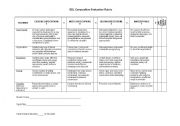
|
ESL Composition Rubric
This rubric is to be used for written compositions, papers, critiques, etc. It is still a work in progress, so feedback is welcome.
Criteria include: Task/Content, Organization, Expression, Format, and Creativity (optional)
The highest expectation is on the left to be read first, indicating that it is the most important, and visually "sets the bar" for your students. If students are from a culture where reading goes right to left, etc, it may be worth pointing out the priority difference. Students should have a copy of the rubric when a project is assigned, so that they know what level they should be working for.
There are columns for Self-Grade and Teacher Grade, which is a useful tool for student reflection. It also gives the teacher a good idea of what the student has earned, because students tend to be surprisingly honest when they have to justify themselves. The +/- columns allow you to rate a performance as "somewhere in between"--even decimals are good here!
I recommend considering each point column as a letter grade and not necessarily assign give the actual points for each criteria. 4=A or 90 and above, 3=B or 80, 2=C or 70, 1=D or 60, and 0=F or below 60. This gives the teacher some leeway to decide on what the student deserves. You could calculate it like a Grade Point Average, or even visually say, "this looks like a B, because the scores tend to center around the 3 column". I also like to take scores out of 10 points, like 8.8, which translates to 88, and I can think of them as letter grades that way too (B+). Whole number mathematics donīt allow for students to make "small progress".
For an example on why I donīt like "mathematical rubrics", look at the example I gave in my "Project Grading Rubric" post.
Furthermore, not all criteria should be considered equal, sometimes you may want to focus on one area, and mathematically it is difficult to get your scores to equal what you would like them to. Also, students may make up for a weighted area through other strengths and it is difficult to reward this mathematically.
Remember, rubrics help put something as subjective as grading an essay into a concrete form, however grading remains subjective so the device needs to maintain plasticity.
Level:advanced
Age: 10-17
Downloads:5 |
|
Copyright 25/6/2008 Beth Hennes
Publication or redistribution of any part of this
document is forbidden without authorization of the
copyright owner.
|


see more worksheets by bhennes2
|